When it comes to fitness, a well-defined back is essential for achieving an aesthetically pleasing physique. Not only does it look good, but it also plays a significant role in overall strength and stability.
However, training your back muscles can be challenging, especially if you have limited space or equipment.
That's where back exercises with dumbbells come in. For these exercises, all you need is a pair of adjustable dumbbells. These exercises offer a versatile and effective way to sculpt a strong, well-defined back, even with minimal equipment.
Let’s dive into 16 powerful dumbbell exercises to transform your back!
16 Powerful Dumbbell Back Exercises to Build Strength and Sculpt Your Back
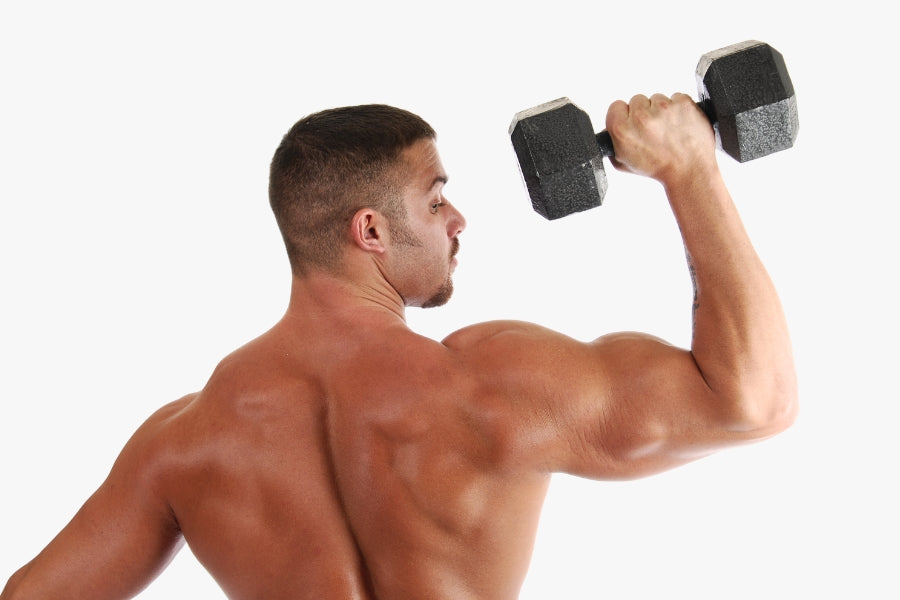
Targeting your back muscles is essential for building strength and achieving definition. These 16 dumbbell exercises will help you sculpt a strong, aesthetic back, focusing on various muscle groups to ensure balanced development.
1. Dumbbell Lat Pullovers

Dumbbell lat pullovers primarily target the lats, chest, and triceps while also engaging the shoulders. This exercise helps to expand the ribcage and increase flexibility in the upper back, contributing to better posture and a more sculpted upper body.
This movement also provides a great stretch to the upper body, helping increase flexibility and range of motion in the shoulders and upper back.
By regularly performing this exercise, you'll build strength in the lats and enhance muscle definition, making it a must-do for anyone looking to improve back aesthetics.
How to Perform Dumbbell Lat Pullovers
- Lie flat on your back on a bench, holding a dumbbell with both hands above your chest.
- Lower the dumbbell backward in a smooth, controlled arc, extending your arms fully overhead.
- Engage your back muscles to pull the dumbbell back up to the starting position, squeezing your lats at the top of the movement.
2. Dumbbell Bent Over Rows
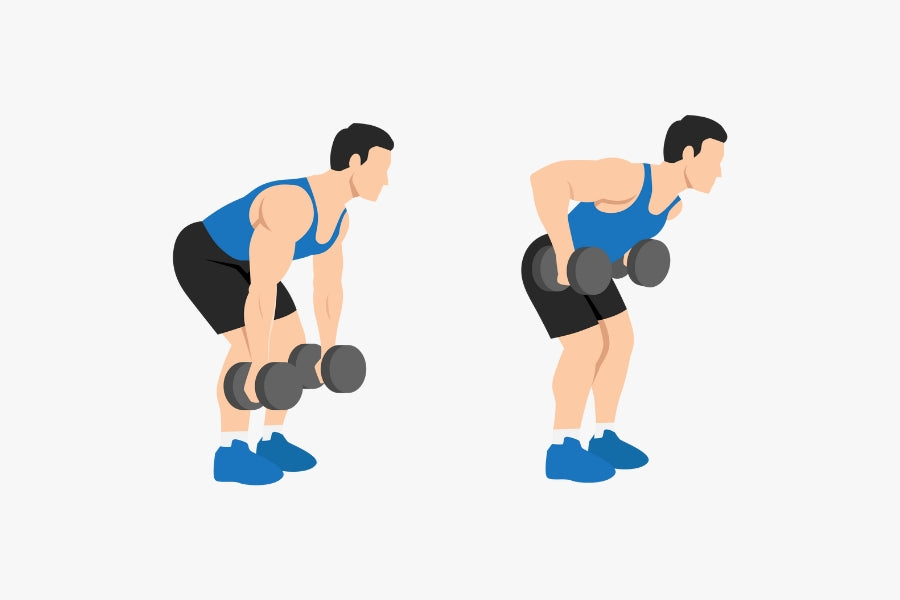
Dumbbell bent over rows primarily target the lats, helping to build strength and stability in the back. This exercise also engages the traps, rhomboids, and rear delts, making it a key movement for building a strong, defined back.
In addition to strengthening the upper back, bent over rows improve posture by enhancing the stability of the shoulder blades and spine. Regularly incorporating this exercise into your routine will help improve overall back strength and muscle definition.
How to Perform Dumbbell Bent Over Rows
- Hold a dumbbell in each hand, bending your hips and keeping your back straight, with a slight bend in your knees.
- Pull the dumbbells towards your lower ribs, squeezing your shoulder blades together at the top of the movement.
- Slowly lower the dumbbells back down in a controlled manner, maintaining proper posture throughout.
3. Dumbbell Single-Arm Rows

Dumbbell single-arm rows are a great exercise for targeting the lats, traps, and rhomboids while also improving unilateral strength and stability. By working one side at a time, this movement helps address any muscle imbalances, ensuring a more balanced and stronger back.
In addition to strengthening the back, this exercise also enhances core stability, as you need to engage your core to maintain proper posture throughout the movement. Regularly performing single-arm rows will improve your overall back strength and muscle definition.
How to Perform Dumbbell Single-Arm Rows
- Kneel on a bench, placing one knee and hand on it while holding a dumbbell in the opposite hand.
- Pull the dumbbell toward your hip, keeping your back flat and your elbow close to your body.
- Lower the dumbbell back down slowly and repeat on the other side for balanced development.
4. Dumbbell Chest Supported Rows
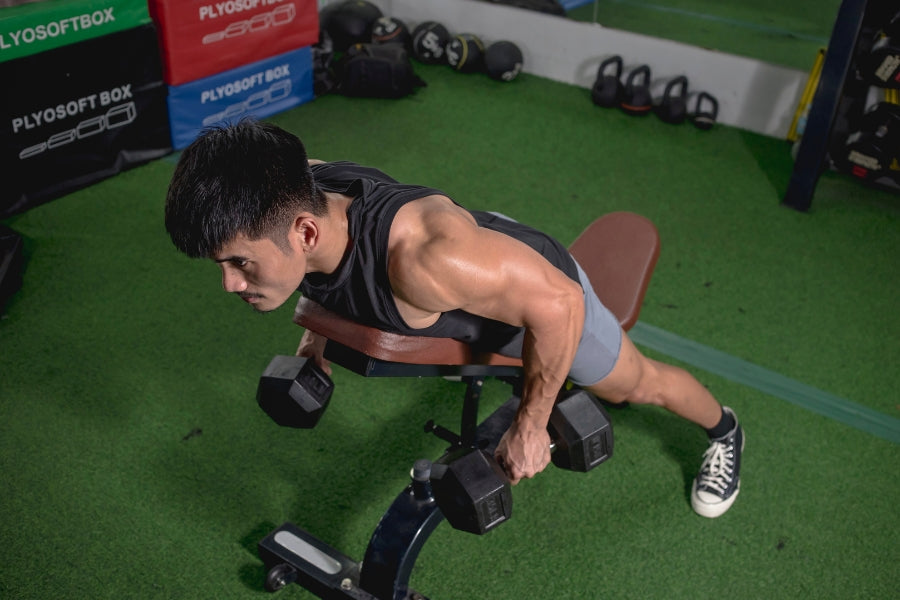
Dumbbell chest supported rows are excellent for targeting the lats, traps, and rhomboids, while minimizing strain on the lower back. By performing this exercise with your chest supported on a bench, you can isolate the back muscles more effectively, improving muscle activation and promoting balanced growth.
This movement not only helps develop upper back strength but also enhances posture by engaging the rear delts and shoulders. It's an ideal addition to any back routine, providing stability and control while ensuring you don’t compromise on form.
How to Perform Dumbbell Chest Supported Rows
- Lie face down on a bench with a dumbbell in each hand, ensuring your chest is supported and feet are firmly planted on the floor.
- Pull the dumbbells toward your hips, squeezing your shoulder blades together at the top of the movement.
- Slowly lower the dumbbells back to the starting position, maintaining control throughout the movement.
5. Dumbbell Seal Rows
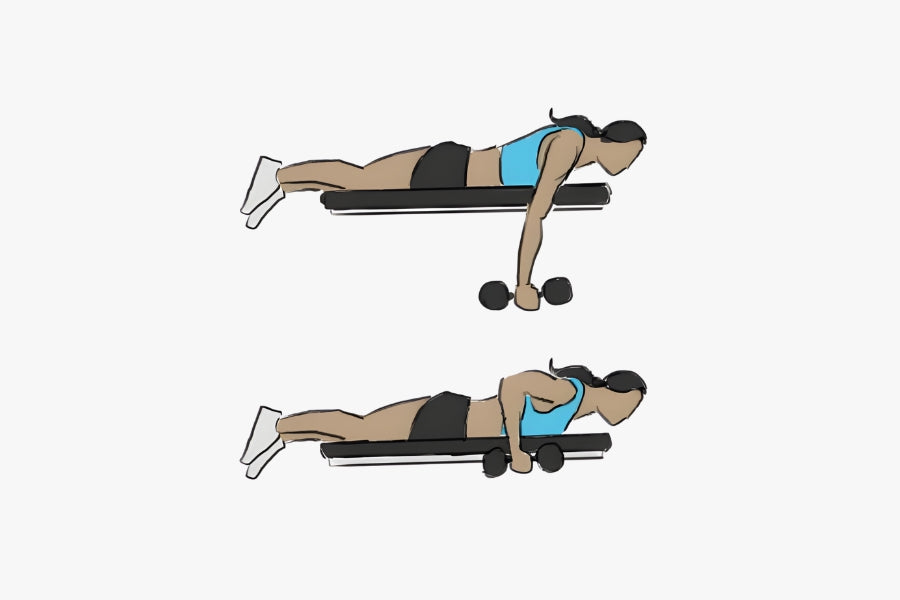
Dumbbell seal rows primarily target the upper back and lats, while emphasizing control for balanced muscle development. This exercise is great for building upper back strength and muscle definition, as the bench position isolates the back muscles, reducing the involvement of other muscle groups.
The movement helps improve posture and stability by engaging the shoulder blades and rear delts. Incorporating seal rows into your routine will enhance your back aesthetics and overall strength by focusing on controlled movements and proper form.
How to Perform Dumbbell Seal Rows
- Lie face down on a flat bench, keeping your chest and stomach supported with your arms hanging straight down, holding a dumbbell in each hand.
- Pull the dumbbells toward your hips, squeezing your shoulder blades together at the top of the movement.
- Lower the dumbbells back to the starting position with control, keeping your core engaged throughout the movement.
6. Dumbbell Bent Over Supinated Rows
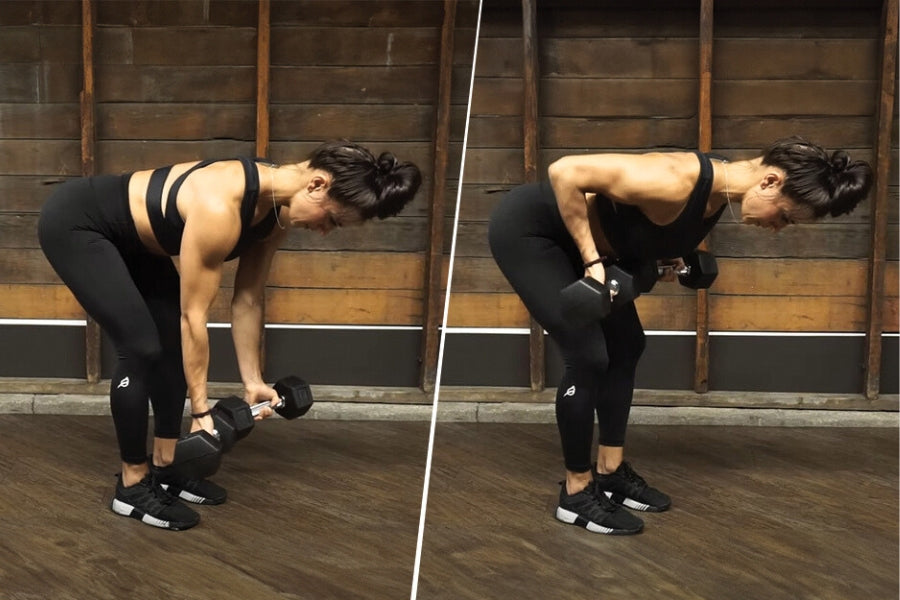
Dumbbell bent over supinated rows target the lats and upper back while utilizing a unique supine grip. This variation activates the muscles in a different way, improving overall back strength and enhancing muscle definition by engaging the forearms, biceps, and shoulders more effectively.
Performing this exercise with a supinated grip allows for a greater range of motion and helps engage the upper back muscles more fully. It’s an excellent addition to your back workout routine, providing a fresh challenge for balanced muscle development and overall strength.
How to Perform Dumbbell Bent Over Supinated Rows
- Bend at the hips with a slight bend in your knees, holding a dumbbell in each hand with your palms facing toward you (supine grip).
- Pull the dumbbells toward your lower ribs, keeping your elbows close to your sides throughout the movement.
- Slowly lower the dumbbells back to the starting position, maintaining control and focusing on the twisting motion of the wrists.
7. Dumbbell Shrugs
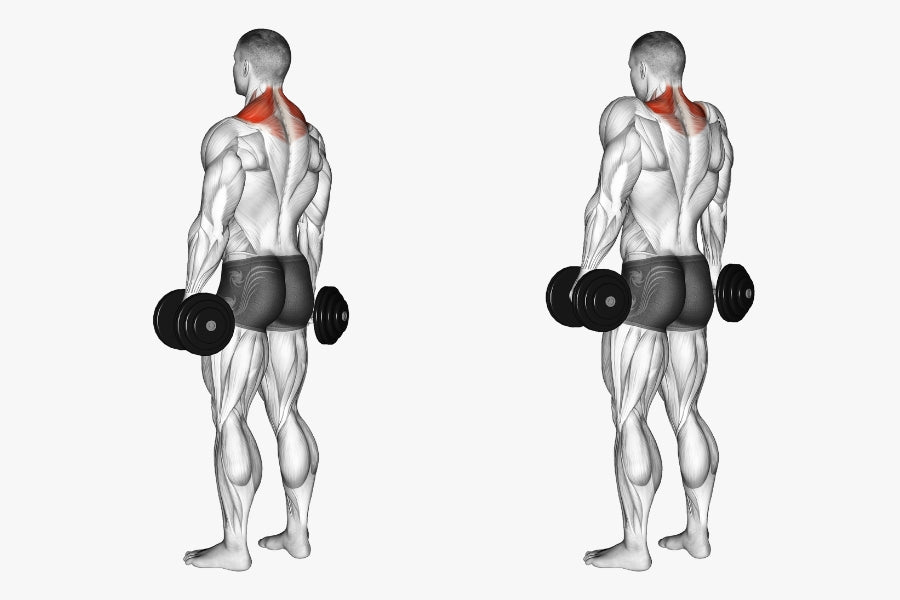
Dumbbell shrugs primarily target the trapezius muscles, helping to build strength and definition in the shoulders and upper back. This exercise is great for improving shoulder aesthetics and creating a more sculpted appearance by developing the upper traps, which are key to shoulder stability and overall posture.
In addition to enhancing the appearance of your shoulders, shrugs help improve shoulder mobility and increase neck strength. Including dumbbell shrugs in your routine will help give your upper body a more powerful and defined look while improving overall functional strength.
How to Perform Dumbbell Shrugs
- Stand straight with a dumbbell in each hand, arms fully extended by your sides.
- Lift your shoulders toward your ears in a controlled motion, squeezing the trapezius muscles at the top.
- Slowly lower the dumbbells back to the starting position, maintaining control throughout the movement.
8. Dumbbell Face Pulls
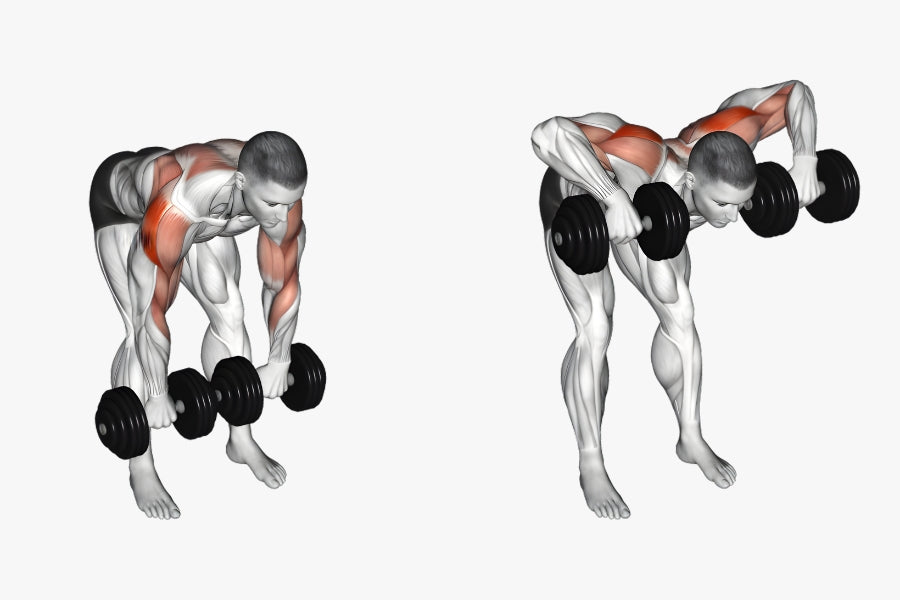
Dumbbell face pulls primarily target the traps and rear delts, helping to develop balanced, strong shoulders. This exercise is excellent for improving shoulder health, posture, and stability by focusing on the often-neglected rear deltoid muscles, which are key for preventing shoulder injuries.
By incorporating face pulls into your routine, you'll enhance shoulder mobility and strength, promoting better posture and a more well-rounded shoulder appearance. This movement helps correct imbalances that can arise from heavy pressing exercises, ensuring the shoulders are evenly developed.
How to Perform Dumbbell Face Pulls
- Hold a dumbbell in each hand with a neutral grip (palms facing each other), and stand with your feet shoulder-width apart.
- Hinge at the hips slightly, keeping your back straight and your core engaged. Lift the dumbbells in front of you with your arms straight, and then pull the dumbbells towards your face by bending your elbows and flaring them out to the sides.
- Pause at the top, squeezing your rear delts and traps, and then slowly return to the starting position with control.
9. Dumbbell Upright Rows
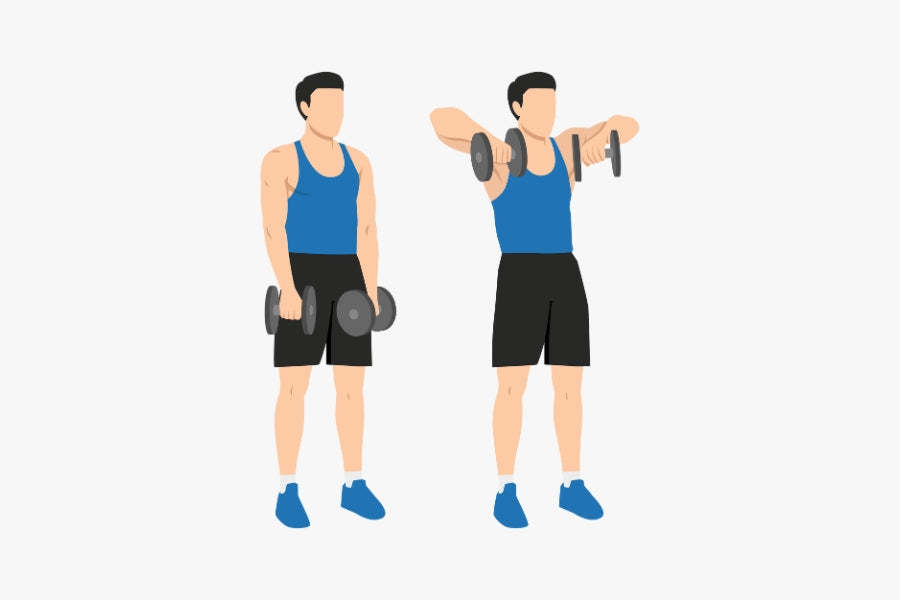
Dumbbell upright rows primarily target the traps and mid-back, contributing to shoulder definition and strength. This exercise helps to improve posture and build the upper back and shoulder muscles, giving your shoulders a well-defined and sculpted appearance.
By regularly performing upright rows, you'll develop both the traps and deltoids, enhancing overall upper body strength and aesthetics. It's a great movement to incorporate into your routine to ensure balanced muscle development across the shoulders and upper back.
How to Perform Dumbbell Upright Rows
- Stand with your feet shoulder-width apart, holding a dumbbell in each hand with your palms facing your body.
- Pull the dumbbells upwards towards your chin, keeping them close to your body and your elbows higher than your wrists.
- Lower the dumbbells back down in a controlled manner, maintaining proper posture and engaging your traps throughout the movement.
10. Reverse Flyes

Reverse flyes primarily target the middle back, helping to build definition and strength in the rear delts and rhomboids. This exercise is great for improving posture and adding symmetry to your back by developing the muscles that are often neglected during other upper-body movements.
By incorporating reverse flyes into your routine, you’ll strengthen the upper back and shoulders, which contributes to a well-rounded and balanced physique. This movement is also essential for maintaining good posture and preventing muscle imbalances from repetitive forward movements like pressing exercises.
How to Perform Reverse Flyes
- Bend at the hips with a slight bend in your knees, holding a dumbbell in each hand with your palms facing each other.
- Lift the dumbbells out to the sides, keeping your arms straight and squeezing your shoulder blades together at the top of the movement.
- Lower the dumbbells back to the starting position with control, maintaining proper posture throughout the exercise.
11. Dumbbell Bent Over Pronated Rows
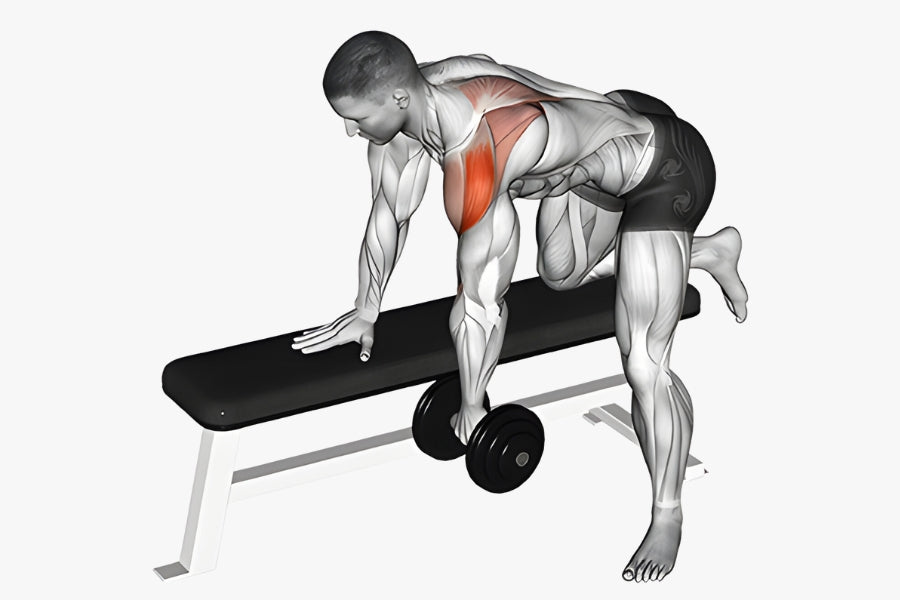
Dumbbell bent over pronated rows target the mid-back muscles, including the lats, rhomboids, and traps, using a pronated (overhand) grip. This variation of the row activates different muscles in the back, helping to improve overall back strength and muscle definition.
By incorporating this exercise into your routine, you'll build a thicker, stronger back with better muscle engagement across multiple areas of the upper back. The pronated grip helps to challenge the back in a different way, ensuring balanced growth and strength.
How to Perform Dumbbell Bent Over Pronated Rows
- Set a flat bench in front of you, and place one knee and hand on it for support, keeping your back flat and parallel to the floor.
- Hold a dumbbell in your free hand with a pronated grip (palms facing away from you), keeping your core engaged and your body stable.
- Pull the dumbbell towards your lower ribs, keeping your elbow close to your body, and squeeze your back muscles at the top.
- Slowly lower the dumbbell back to the starting position with control, and repeat on the other side.
12. Dumbbell Deadlifts
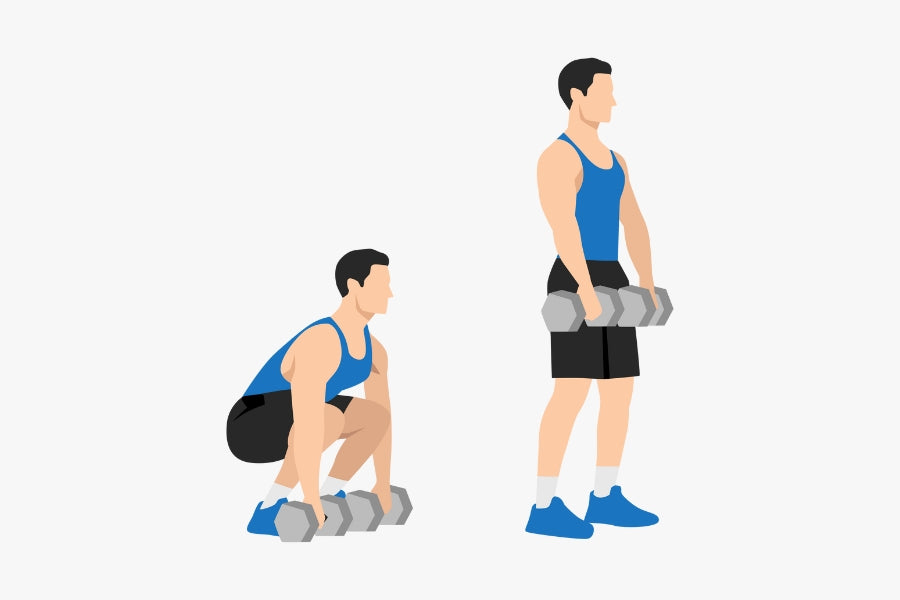
Dumbbell deadlifts target the lower back, glutes, and hamstrings while also engaging the upper back for added strength and muscle definition. This compound movement builds functional strength and helps improve posture by activating the muscles along your posterior chain.
In addition to strengthening the back, dumbbell deadlifts improve your core stability and overall athletic performance. It’s a key exercise for building total-body strength and creating a balanced, strong physique from the lower to upper back.
How to Perform Dumbbell Deadlifts
- Stand with a dumbbell in each hand, feet hip-width apart, and your arms fully extended in front of your thighs.
- Bend at the hips, keeping your back flat, and lower the dumbbells toward the ground while maintaining a slight bend in your knees.
- Engage your glutes and hamstrings to stand back up, squeezing your glutes at the top of the movement, and return to the starting position.
13. Single-Arm Dumbbell Deadlifts
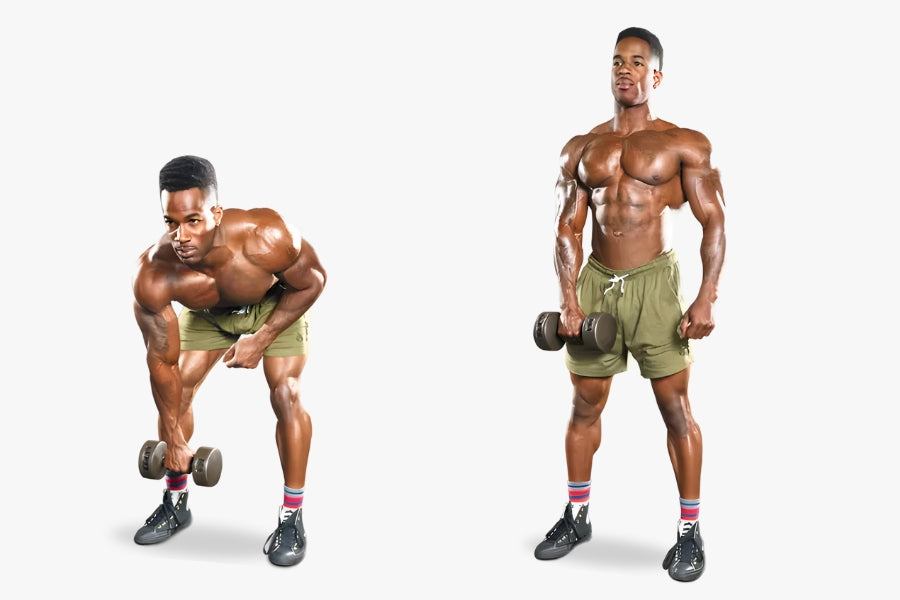
Single-arm dumbbell deadlifts target the muscles in the back, glutes, and hamstrings, working each side individually to improve strength and balance. This unilateral movement helps correct imbalances between sides, enhancing overall muscle development and posture.
In addition to strengthening the posterior chain, this exercise improves core stability by engaging your obliques and lower back. It’s perfect for developing strength and symmetry in the back, making it an essential addition to your routine.
How to Perform Single-Arm Dumbbell Deadlifts
- Hold a dumbbell in one hand with your feet hip-width apart and your back flat, maintaining a slight bend in your knees.
- Bend at the hips, lowering the dumbbell towards the ground while keeping your back straight and your core engaged.
- Stand back up, engaging your glutes and hamstrings, and repeat the movement. Switch sides after completing the set.
14. Superman (Bodyweight Exercise)

The Superman exercise primarily targets the lower back, helping to improve its stability and strength. By lifting both your arms and legs off the ground simultaneously, this movement activates the lower back muscles and promotes better posture and core stability.
This bodyweight exercise is excellent for strengthening the posterior chain and improving overall back health. It’s an effective movement for building endurance in the lower back muscles, especially for those who spend long hours sitting or want to prevent back pain.
How to Perform Superman (Bodyweight Exercise)
- Lie face down on the ground with your arms extended in front of you and legs fully stretched out behind you.
- Simultaneously lift your arms and legs off the ground, squeezing your lower back and glutes at the top.
- Hold for a moment, then slowly lower your arms and legs back down in a controlled manner.
15. Dumbbell Renegade Rows
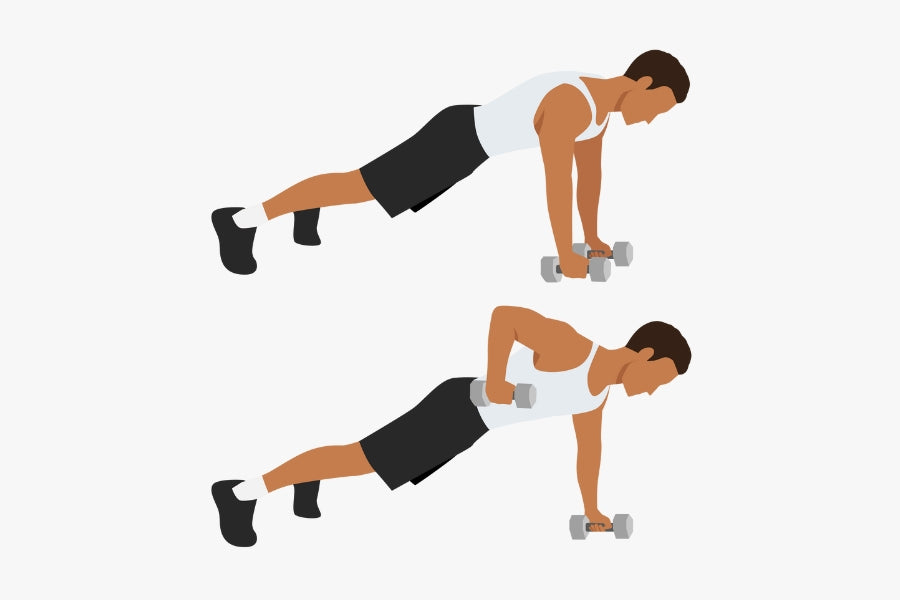
Dumbbell renegade rows target both the back and core, providing a full-body challenge that engages multiple muscle groups. This exercise is excellent for building upper back strength while also strengthening the core and improving stability, making it an effective functional movement for overall body conditioning.
By incorporating renegade rows into your routine, you'll not only improve the strength of your lats, traps, and rhomboids but also enhance your ability to maintain balance and control under load. It’s a great movement for developing core stability while targeting key muscles in the back and shoulders.
How to Perform Dumbbell Renegade Rows
- Start in a plank position, holding a dumbbell in each hand, with your body in a straight line and your feet slightly wider than shoulder-width apart for stability.
- Engage your core and pull one dumbbell towards your hip, keeping your elbow close to your body while balancing on the other hand and maintaining your plank position.
- Slowly lower the dumbbell back to the ground and alternate sides for a complete set, keeping your body as stable as possible throughout the movement.
16. Dumbbell Reverse Lunges with Rotation
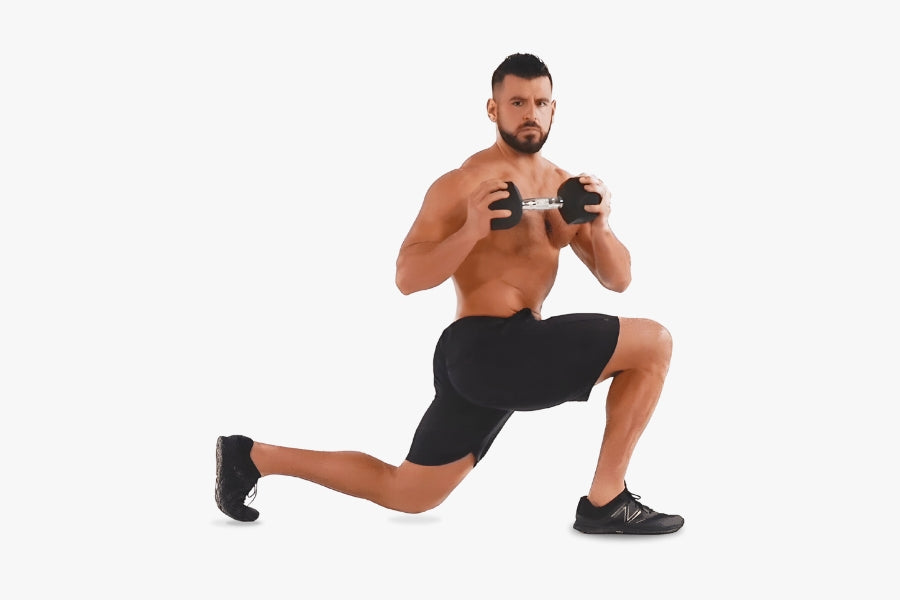
Dumbbell reverse lunges with rotation target the legs, glutes, and back while also engaging the core for stability. This dynamic movement not only strengthens the lower body but also improves rotational flexibility, making it an excellent functional exercise for overall body coordination and balance.
By incorporating this exercise, you’ll enhance your lower body strength, core stability, and mobility, making it a great addition to any workout routine. The added rotation also activates the obliques, promoting better torso strength and flexibility.
How to Perform Dumbbell Reverse Lunges with Rotation
- Hold a dumbbell in each hand and stand with your feet shoulder-width apart.
- Step back with one leg into a lunge, and as you lower yourself, rotate your torso toward the leg that is lunging.
- Return to the starting position, switch legs, and repeat, maintaining control throughout the movement.
The Importance of a Back-Focused Warm-Up
Please remember to warm up your back muscles properly before jumping into your dumbbell back exercises.
Warming up will not only increase blood flow but also prepare your muscles for the workout ahead, reducing the risk of injury.
To optimize your warm-up routine, it is recommended to incorporate dynamic stretches, light cardio, and specific back stretches.
Adjustable Dumbbells: A Compact Solution for Home Gyms
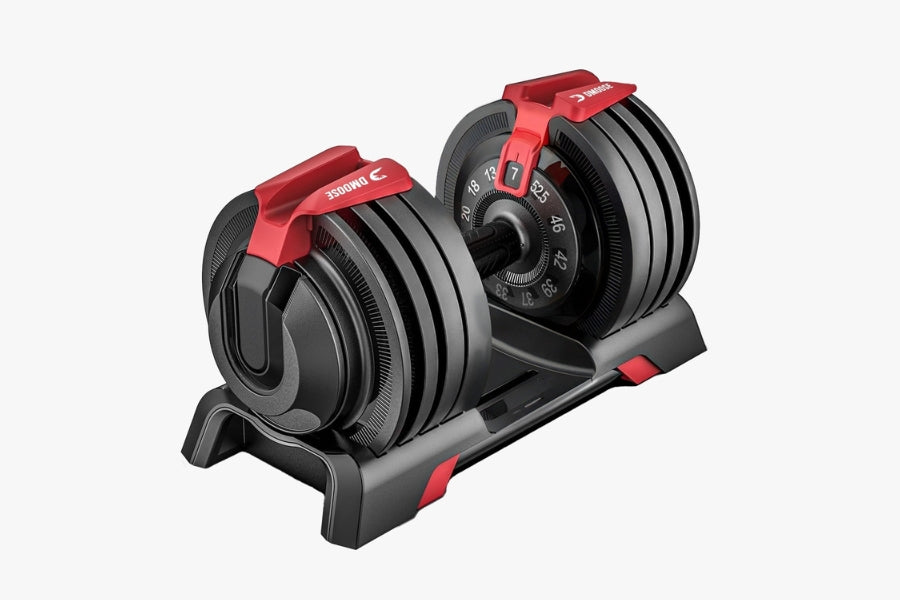
Dumbbells are essential for any home gym, offering versatility and convenience for a variety of exercises. However, traditional dumbbells can take up a lot of space and be expensive to buy in multiple weights.
That’s where DMoose Adjustable Dumbbells stand out, providing 12 weight options ranging from 7 lbs. to 52.5 lbs., replacing a cluttered weight rack with just one compact set. This makes it easier and more cost-effective to target different muscle groups.
Adjusting the weight is incredibly fast and easy with a one-hand adjustment handle, allowing you to change weights in seconds. The unique double safety lock system ensures secure adjustments, keeping your workout safe and effective.
The non-slip silicone rubber handle grip adds stability, while the space-saving design frees up 80% of your storage space. Made with high-quality materials like steel and nylon, these durable dumbbells are perfect for anyone looking for a space-efficient, premium workout tool at home.
FAQs
Q: How often should I incorporate Dumbbell Back Exercises into my routine?
For optimal muscle recovery and growth, aim to perform back dumbbell exercises two to three times per week, allowing sufficient rest between sessions.
Q: Can beginners perform Deadlifts safely?
Yes, beginners can perform deadlifts safely by focusing on proper form and starting with lighter weights. Gradually increase the weight as your form improves and strength builds.
Q: How do I perform Dumbbell Rows with proper form?
To perform Dumbbell Rows correctly, it’s essential to maintain balance and good posture. Use mirrors, videos, or a partner to ensure you're focusing equally on both sides and engaging the muscles properly.
Q: How can I prevent muscle imbalances during Dumbbell Rows?
Prevent muscle imbalances by ensuring you maintain proper form and balance throughout the movement. Utilize mirrors or work with a partner to monitor your technique and correct any form discrepancies.
Q: Is it necessary to use a lifting belt during Bent-Over Rows?
While a lifting belt is not required, it can provide added support during heavy Bent-Over Rows. However, always prioritize proper form over the use of a belt.
Q: Can Dumbbell Back Exercises replace machine-based back workouts?
Dumbbell back exercises are highly effective and versatile, but for optimal back development, a balanced approach that includes both free weights and machine-based exercises is ideal.
Final Thoughts
A strong, well-defined back is key to both an aesthetically pleasing physique and overall strength and stability.
With DMoose Adjustable Dumbbells, you can efficiently target every muscle in your back while saving space and enhancing your workout experience.
Stay consistent with these 16 exercises, and you'll soon see a stronger, more defined back that boosts both your confidence and performance!
Related Articles
Back Workout: Build Your Lats With These 7 Lat Pulldown Variations
Adjustable Dumbbells: Science & Magic to Revolutionize Your Fitness Routine
Dumbbell Dilemma: The Ins & Outs of Adjustable vs. Fixed Dumbbells
10 Best Barbell Exercises for Strengthening Your Back
Barefoot Training: How Training Barefoot Can Make You Stronger














